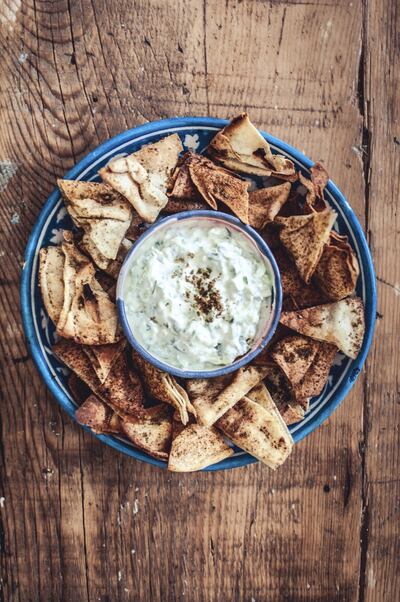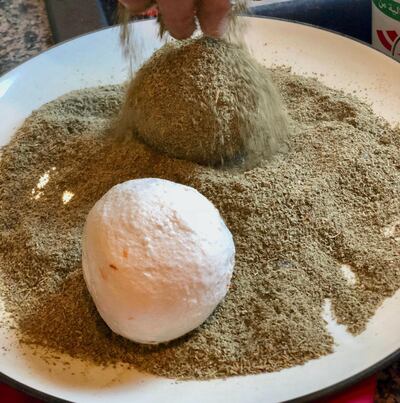While those living in the UAE might well scoff at the idea of zaatar as a modern-day food trend, let's take a second to reflect that not everyone has easy access to the piping hot manakish zaatar that we do. Cause for consternation indeed.
Steps are being made to put that culinary wrong right, though. The fragrant, centuries-old spice blend, that's such a cornerstone of Middle Eastern cooking, is increasingly garnering attention all over the world. American supermarket chain Whole Foods Market cited Middle Eastern ingredients, and zaatar in particular, as one of its food trends last year; drinks made with zaatar have been popping up on bar menus around the world; and the influence of the culinary giant that is Yotam Ottolenghi has familiarised the masses with the ingredient, particularly in the UK where a trendy restaurant brunch menu wouldn't be complete without zaatar featuring somewhere.
As those in the know will attest, this focus is well deserved. A scant sprinkling of the distinctive spice mix yields nothing short of transformative results: zaatar adds interest to all manner of vegetables – both roasted and raw – ramps up the taste of pulses, meat and fish with ease, bestows depth of flavour upon dairy products, and lends a complex savoury note to bread doughs and bakes.
The details
Zaatar (scientific name Origanum syriacum) is the name for both the wild, bushy herbaceous plant that grows so abundantly across the Levant and the herb mix itself (which is made from the dried and ground leaves of said plant).
Zaatar recipes, meanwhile, spark hotly contested debate across countries, regions and even families. Some argue that to dilute the blend with anything other than zaatar, sumac, sesame seeds and salt is something of a travesty (the aforementioned Ottolenghi is of this purist school of thought), while others happily include marjoram, oregano and dried thyme in their concoctions.
If you do fancy making your own zaatar from scratch, it's worth experimenting with these ingredients and quantities until you settle on a preferred flavour – just don't stint on the zaatar whatever you do and store the results in an airtight container.
Beyond manakish
As delicious as the combination of zaatar, molten cheese and hot, fresh bread is, there is a huge variety of uses for the ingredient. An easy way to expand your repertoire is to make a big batch of zaatar oil (work on a ratio of two parts olive oil to one part zaatar), keep it on hand in your pantry and use in any number of dishes.
Brush over whole chicken before roasting with plenty of lemons. Stir zaatar into breadcrumbs then use to coat strips of meat and fish or top gratins. Sprinkle the condiment over soups for extra pizzazz. Or make a zippy, zingy salad dressing by whisking together extra virgin olive oil, zaatar, lemon juice and zest and a splash of pomegranate molasses.
Make zaatar crisps by cutting Arabic bread into pieces, drizzling generously with oil and baking in the oven until golden.
Should you fancy jumping on the drinks’ trend, blitz cucumbers to a pulp in a blender along with a little zaatar and a good squeeze of lemon. Leave to infuse for half an hour or so, then strain and serve over ice.
Zaatar works in sweet dishes, too. For an easy introduction, make home-made zaatar-chocolate bark by spreading melted dark chocolate on to a tray lined with baking paper and topping with zaatar, chopped pistachios and dried cranberries. Chill in the fridge until firm, then break into shards.
International Zaatar Day
Tina Chamoun, a Lebanese-American who lives in Ohio but spent her childhood summers in Lebanon, is the founder of YourLebanon.com, a website and initiative dedicated to celebrating Middle Eastern cuisine, cooks, recipes and ingredients. She is also the driving force behind the inaugural International Zaatar Day, which took place last month on September 23.
"I am very passionate about Lebanon and our food, and I want more people to experience it," she says. "I started YourLebanon.com to share Lebanese recipes in English, so that they become more accessible to those who want to learn about Lebanon and our food, but don't know Arabic," she explains.
Chamoun says that Zaatar Day is an extension of that idea: “I wanted it to be a day when those familiar with zaatar can share their love and experiences with it with the world. We feel that many people would benefit from learning about zaatar and its multipurpose uses,” she adds.
That said, Chamoun is quick to point out that, in her eyes, "Zaatar Day is truly every day". She says: "Growing up, we were always told to eat zaatar in the morning because it would make you sharper for your day, so in our household we eat zaatar multiple times a week, if not daily."



